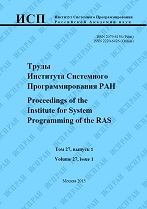|
Usage of i-vectors for automated determination of a similarity level between languages
A. A. Bērziņš
University of Latvia
Abstract:
The article describes results of applying i-vectors-based (both LID and SID) speech identification methods to define a kind of a distance between languages (in a wide sense of the word – including dialects and any other forms of spoken language). Spontaneous speech recordings of many enough speakers of languages are used on the input of the method. The experiments were carried out at recordings of Latvian and Latgalian dialects, but the method is applicable to any other idioms. Cosine similarity, Euclidean metric, standardized Euclidean metric, Jordan (or Chebyshov) metric and city block (or L1) metric were tried out. Cosine similarity worked well for SID i-vectors, but for unknown reasons was senseless for LID i-vectors. Jordan metric worked well for LID, but was not good enough for SID i-vectors. Standardization of the Euclidean metric does not gave any improvement. Thus, the conclusions are: 1) both SID and LID vectors of full length recordings of spontaneous speech are characterizing and representing languages good enough to be used for detection of a distance between languages; 2) the best metrics for such tasks are Euclidean and L1 (for arithmetic mean vectors computed from i-vectors of all informants coordinate by coordinate).
Keywords:
speech, idiom, language, dialect, i-vector, LID, SID, recording, proximity of languages, distance between languages.
Citation:
A. A. Bērziņš, “Usage of i-vectors for automated determination of a similarity level between languages”, Proceedings of ISP RAS, 31:5 (2019), 153–164
Linking options:
https://www.mathnet.ru/eng/tisp461 https://www.mathnet.ru/eng/tisp/v31/i5/p153
|

| Statistics & downloads: |
| Abstract page: | 147 | | Full-text PDF : | 27 | | References: | 19 |
|




 Contact us:
Contact us: Terms of Use
Terms of Use
 Registration to the website
Registration to the website Logotypes
Logotypes









 Citation in format
Citation in format 